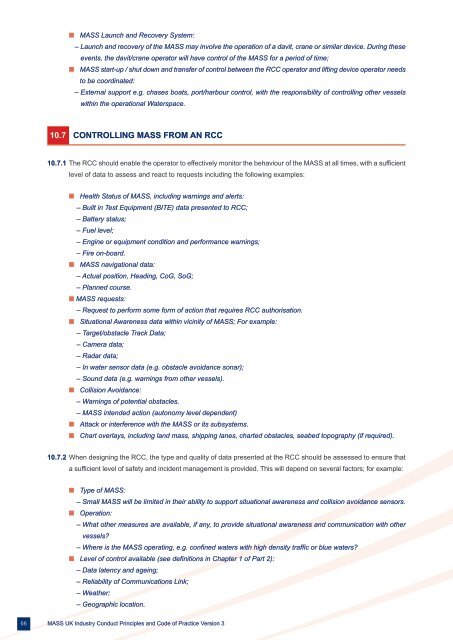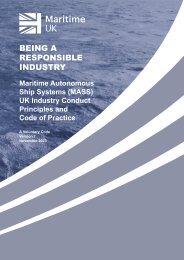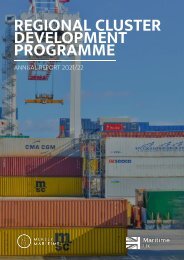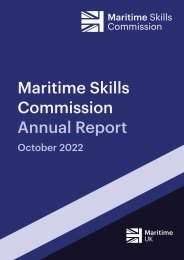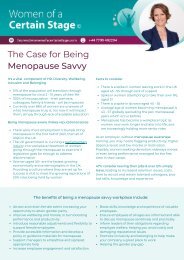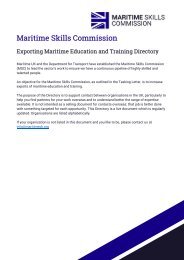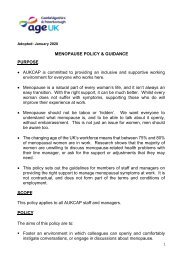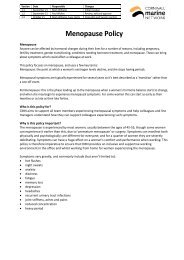code_of_practice_V3_2019
You also want an ePaper? Increase the reach of your titles
YUMPU automatically turns print PDFs into web optimized ePapers that Google loves.
n MASS Launch and Recovery System:<br />
– Launch and recovery <strong>of</strong> the MASS may involve the operation <strong>of</strong> a davit, crane or similar device. During these<br />
events, the davit/crane operator will have control <strong>of</strong> the MASS for a period <strong>of</strong> time;<br />
n MASS start-up / shut down and transfer <strong>of</strong> control between the RCC operator and lifting device operator needs<br />
to be coordinated:<br />
– External support e.g. chases boats, port/harbour control, with the responsibility <strong>of</strong> controlling other vessels<br />
within the operational Waterspace.<br />
10.7 CONTROLLING MASS FROM AN RCC<br />
10.7.1 The RCC should enable the operator to effectively monitor the behaviour <strong>of</strong> the MASS at all times, with a sufficient<br />
level <strong>of</strong> data to assess and react to requests including the following examples:<br />
n Health Status <strong>of</strong> MASS, including warnings and alerts:<br />
– Built in Test Equipment (BITE) data presented to RCC;<br />
– Battery status;<br />
– Fuel level;<br />
– Engine or equipment condition and performance warnings;<br />
– Fire on-board.<br />
n MASS navigational data:<br />
– Actual position, Heading, CoG, SoG;<br />
– Planned course.<br />
n MASS requests:<br />
– Request to perform some form <strong>of</strong> action that requires RCC authorisation.<br />
n Situational Awareness data within vicinity <strong>of</strong> MASS; For example:<br />
– Target/obstacle Track Data;<br />
– Camera data;<br />
– Radar data;<br />
– In water sensor data (e.g. obstacle avoidance sonar);<br />
– Sound data (e.g. warnings from other vessels).<br />
n Collision Avoidance:<br />
– Warnings <strong>of</strong> potential obstacles.<br />
– MASS intended action (autonomy level dependent)<br />
n Attack or interference with the MASS or its subsystems.<br />
n Chart overlays, including land mass, shipping lanes, charted obstacles, seabed topography (if required).<br />
10.7.2 When designing the RCC, the type and quality <strong>of</strong> data presented at the RCC should be assessed to ensure that<br />
a sufficient level <strong>of</strong> safety and incident management is provided. This will depend on several factors; for example:<br />
n Type <strong>of</strong> MASS:<br />
– Small MASS will be limited in their ability to support situational awareness and collision avoidance sensors.<br />
n Operation:<br />
– What other measures are available, if any, to provide situational awareness and communication with other<br />
vessels?<br />
– Where is the MASS operating, e.g. confined waters with high density traffic or blue waters?<br />
n Level <strong>of</strong> control available (see definitions in Chapter 1 <strong>of</strong> Part 2):<br />
– Data latency and ageing;<br />
– Reliability <strong>of</strong> Communications Link;<br />
– Weather;<br />
– Geographic location.<br />
66<br />
MASS UK Industry Conduct Principles and Code <strong>of</strong> Practice Version 3


